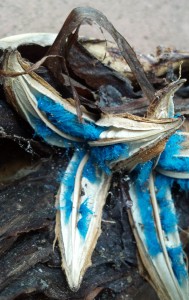Shades of Blue
Posted in Around the Garden on March 25 2013, by Jessica Clarke
Jessica Clarke is the Associate Curator of Glasshouse Collections at The New York Botanical Garden.
 Ravenala madagascariensis, better known as traveler’s palm, is a plant endemic to Madagascar which can be found in our very own Enid A. Haupt Conservatory (Palm Dome). In addition to its very attractive fan-shaped arrangement of leaves, it has another unique attribute that isn’t often witnessed.
Ravenala madagascariensis, better known as traveler’s palm, is a plant endemic to Madagascar which can be found in our very own Enid A. Haupt Conservatory (Palm Dome). In addition to its very attractive fan-shaped arrangement of leaves, it has another unique attribute that isn’t often witnessed.
Like a jewel box opening up, its dried brown fruit pod splits apart to reveal remarkable sapphire-colored seeds inside. The reason that they are blue? It can be considered a “tale of two endemics,” or the supposed co-evolution of the traveler’s palm with another species found only in Madagascar—the ruffed lemur.
The lemurs are astute pollinators of Ravenala; they use their long tongues to reach the nectar deep inside the flowers. In this way, they collect and transfer pollen on their snouts from plant to plant. Once pollinated, the flowers develop into seed pods, which mature and dry before splitting to expose the bounty inside. The fuzzy blue appendage, or aril, that is attached to the seed is edible—and it encourages animals to eat it and aid in seed dispersal. In this case the animal that it solely appeals to is the lemur, which is only capable of seeing shades of blue and green.
[Not a valid template]
Ed. Note: The traveler’s palm is just one in a growing line of co-evolving plants to find its way to Plant Talk in recent months, and with good reason–they’re super interesting. The adaptive compromises of plants like Darwin’s star orchid and the stinky toe tree, to name only two, are all the more fascinating when paired with the strange creatures that work to help pollinate them! Stay tuned for more on this fascinating topic as we move into spring.
Lemur image courtesy of Wikimedia Commons.


…the concept of co-evolution is very interesting….it seems that the island of Madagascar is fertile ground for this phenomenon….
that the lemurs can see these specific colors is awesome….thank you so much for sharing this knowledge….